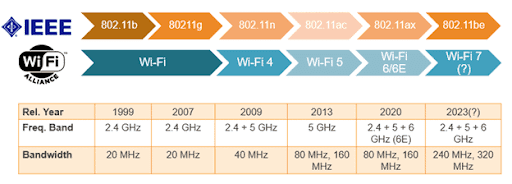Wireless Modulation - BPSK, QPSK and QAM
Modulation is one of the key components relating to how your network traffic is translated into a format that is traversable over any network infrastructure either wired or (and the topic of this post) wireless connections. Modulation sits at the lowest level of the OSI model, the Physical Layer (Layer 1).
Think of modulation in a real world example, as a translator. Preparing the data received from the higher layers of the OSI model into a more accessible and easily transmitted format across the network and more specifically relating to Wi-Fi, across the antennas transmitters/receiver hardware.
Wi-Fi modulation has seen many changes across its evolution from it's first initial standard in 1997 and is still changing even now with the currently in development standard Wi-Fi 7 (11be) which we will also cover in terms of it's changes to modulation.
There is three main ways that modulation takes place in Wi-Fi, and they're as follows, Binary Phase Shift Key (BPSK), Quadrature Phase Shift Keying (QPSK), and more notably Quadrature Amplitude Modulation (QAM) which we'll cover below in a little more detail.
We'll first start with the most rudimentary of the three, Binary Phase Shift Key (BPSK). BPSK works by using the phase of a wave to reflect the changes in data. There are two possible outcomes that can occur using BPSK which is a phase change of 180 degrees or an easier way of thinking of it, left and right being a difference between a 0 or 1 being represented.
Due to its lack of complexity you can only represent one bit at any time either being 0 or 1. However it does have a bonus for being so simple, as it has such a high phase degree shift (180 degrees, either left or right side) it means you have a huge margin of error available that even if your signal is terrible it can still be maintained.
It is very unlikely that a signal (without serious issues) can be that far out to the point that it cannot be understood at this level of modulation. Modulation is heavily dependant on the devices Signal to Noise Ratio (SNR), a greater SNR, a greater modulation can be utilised due to the implication that you are less prone to errors while transmitting.
The downsides to BPSK is due to it's simplicity, it is the slowest form of modulation agai, due to the limitation of only being able to represent one bit at a time.
Second up is Quadrature Phase Shift Keying (QPSK). QPSK is similar to BPSK where it utilises phase shifting but with a little extra complexity thrown in. Instead of the two different phases in BPSK, QPSK contains four overall data points, those being 0, 90, 180 and 270 degrees of phase.
As you can see, it is double the number of representable bits with a total of four (two more than BPSK). However, the bonus of a large margin of error with BPSK has been slightly narrowed down to 90 degrees due to adding additional data points. This will require a better Signal to Noise (SNR) but also doubles the overall throughput compared to BPSK.
Finally, Quadrature Amplitude Modulation (QAM). QAM is the last of the modulation schemes, you will see QAM a lot more as this is the primary form of modulation after BPSK and QPSK and their limitations in bits per wave. This adds onto the other modulations types by including amplitude (increase or decrease of the wave) to allow for a larger range of bits being represented at one time. You can always tell how many data points are included in each type of QAM by taking a note of the number at the beginning, for example 16-QAM has 16 available data points (as seen below) and 4096-QAM, the new maximum in Wi-Fi 7 which has a total of 4096 data points.
 |
| 4096-QAM |
The only issue with is more complex versions of QAM, is that that the margin for error gets smaller and smaller. As QAM has such a range of modulation types available, the minimum SNR can be around 11 with high levels of modulation requiring 30/35 plus, something to keep in mind in a noisy environment.
As a final note we are finally getting to the point where it has been hinted that any additional QAM may counter act itself. This comes down to the same story of added complexity. At what point, will the complexity and SNR required but unachievable in a modern office environment for example? Do we expect to see any changes to QAM past Wi-Fi 7, potentially, but it will come to a point where other changes will be needed either to improve SNR or something new entirely.
I highly recommend having a look at the Access Agility MCS chart (link below), it will give you a good idea on the data rates achievable by each modulation type along with the other requirements and their effect on your Wi-Fi data rate (guard interval & spatial streams for example).
Access Agility MCS Chart
https://mcsindex.net/





Comments
Post a Comment